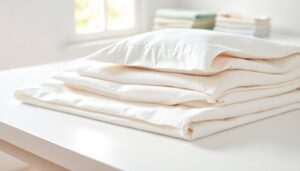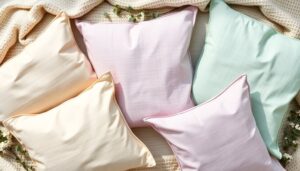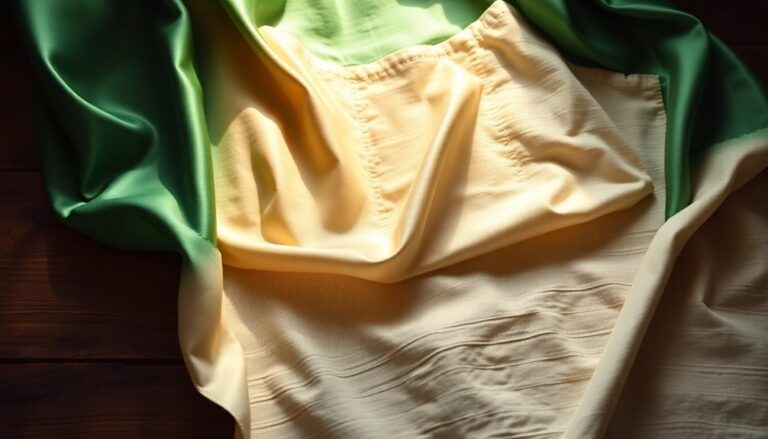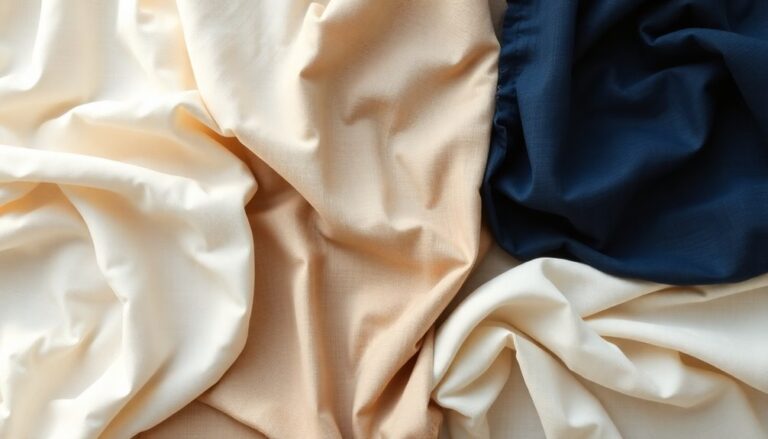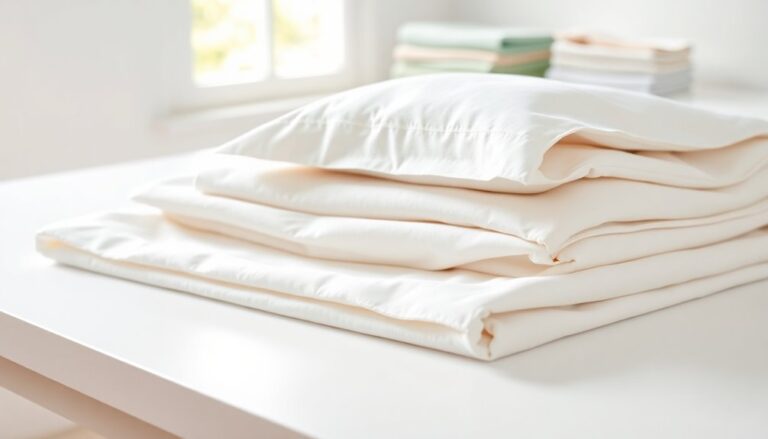Linen and hemp are both natural fibers with unique characteristics. Linen, derived from the flax plant, is soft and smooth, ideal for summer clothing and home textiles. Hemp, originating from the hemp plant, has a coarser texture and is known for its durability, making it suitable for rugged applications like ropes and insulation. Whereas linen requires more cultivation resources, hemp is environmentally friendly with a low ecological footprint. There's much more to discover about their uses and impacts.
Article Highlights
- Linen is made from flax fibers, while hemp is derived from the hemp plant, each with distinct historical and cultural significance.
- Linen has a smooth, silky texture and is more breathable, whereas hemp offers a rugged texture and superior durability.
- Linen requires more water and fertilizers to grow, while hemp is environmentally friendly, needing minimal resources and improving soil health.
- Linen is often used for summer clothing and home textiles, whereas hemp is favored for rugged apparel and eco-friendly products like ropes and rugs.
- The production costs for linen are typically higher due to labor intensity, while hemp is generally more sustainable and potentially less expensive.
Origins of Linen and Hemp

Linen and hemp both boast rich histories rooted in ancient agriculture. Linen, derived from the flax plant, has been used since at least 5000 BC, particularly in Egypt where it held significant historical significance in burial practices. Its cultural relevance extended through Europe, influencing fashion and trade for centuries. Conversely, hemp's origins trace back to Asia, where it was cultivated for its fibers around 8000 BC. This versatile plant played a vital role in early textiles, ropes, and even paper. Both linen and hemp not only served practical purposes but also symbolized wealth and status in their respective cultures. Their enduring legacy reflects their importance in human civilization and the evolution of material culture.
Production Processes
Although both linen and hemp are derived from plants, their production processes differ greatly. Linen is made from the flax plant, requiring a method called retting for fiber extraction, where the stalks are soaked to separate the fibers from the woody parts. After retting, the fibers undergo spinning and weaving, often using traditional processing techniques that highlight their natural luster.
On the other hand, hemp production involves a more straightforward approach. The stalks are harvested and processed using decortication, which separates the fibers from the core. This method is typically faster and results in a coarser fiber. Both plants require careful handling throughout their production processes, but the techniques used reflect their unique characteristics and intended applications.
Texture and Feel
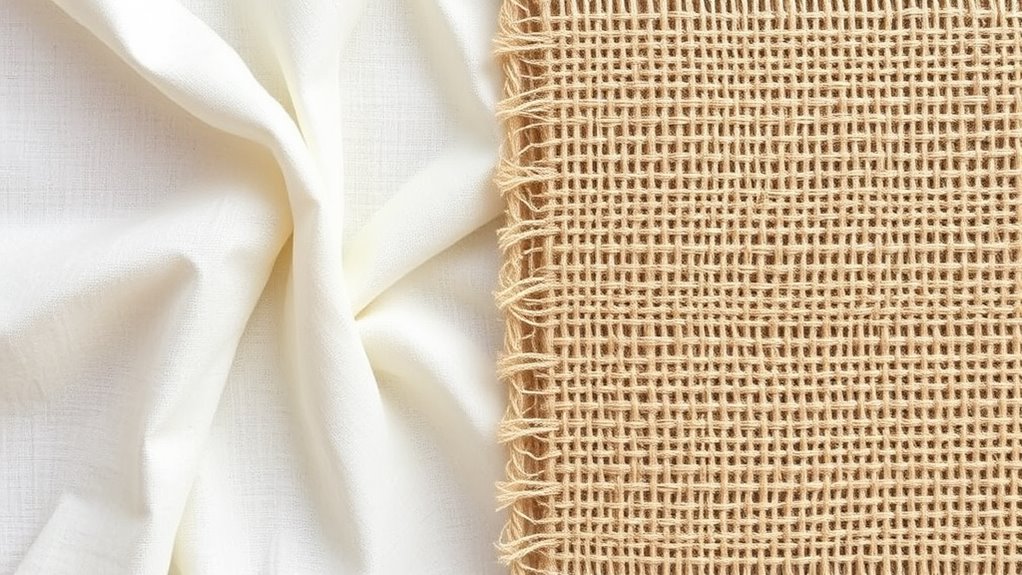
When comparing linen and hemp, their fiber structures play an essential role in determining texture and feel. Both fabrics offer comfort and breathability, but their durability and softness can vary greatly. Comprehending these differences helps consumers choose the right material for their needs.
Fiber Structure Comparison
Both linen and hemp boast unique fiber structures that influence their texture and feel. Linen, derived from flax plants, has long, smooth fibers, lending it a soft, silky touch. Its fiber characteristics allow for a delicate drape, making it popular in apparel and home textiles. In contrast, hemp fibers are shorter and coarser, resulting in a more rugged texture. These structural differences give hemp a sturdier feel, making it ideal for durable products like bags and ropes. Whereas both fibers are strong and breathable, their distinct fiber characteristics cater to different preferences and uses. Ultimately, comprehending these structural differences can help individuals choose the right fabric for their needs.
Comfort and Breathability
How do comfort and breathability differ between linen and hemp? Regarding comfort levels, linen tends to offer a smoother, softer feel against the skin, making it a popular choice for clothing and bedding. Its natural fibers allow for excellent airflow, enhancing its breathability factors. Hemp, although slightly coarser, provides a unique comfort that many appreciate, especially for its durability and eco-friendliness. It furthermore boasts impressive breathability, but might not feel as luxurious as linen. In the end, individuals may prefer linen for a more refined touch, whereas hemp appeals to those seeking a sturdy, breathable fabric. Both materials excel in breathability, but their comfort levels cater to different preferences.
Durability and Softness
Although linen is often celebrated for its luxurious softness, hemp stands out for its remarkable durability. When comparing these two fabrics, durability factors and softness comparison reveal distinct characteristics. Linen, whereas soft against the skin, can wear out more quickly, especially with frequent washing. Conversely, hemp's fibers are stronger and more resistant to wear, giving it a longer lifespan.
| Fabric | Softness |
|---|---|
| Linen | Luxuriously soft |
| Hemp | Coarser at first |
| Becomes softer over time | |
| Exceptionally durable |
Durability and Strength
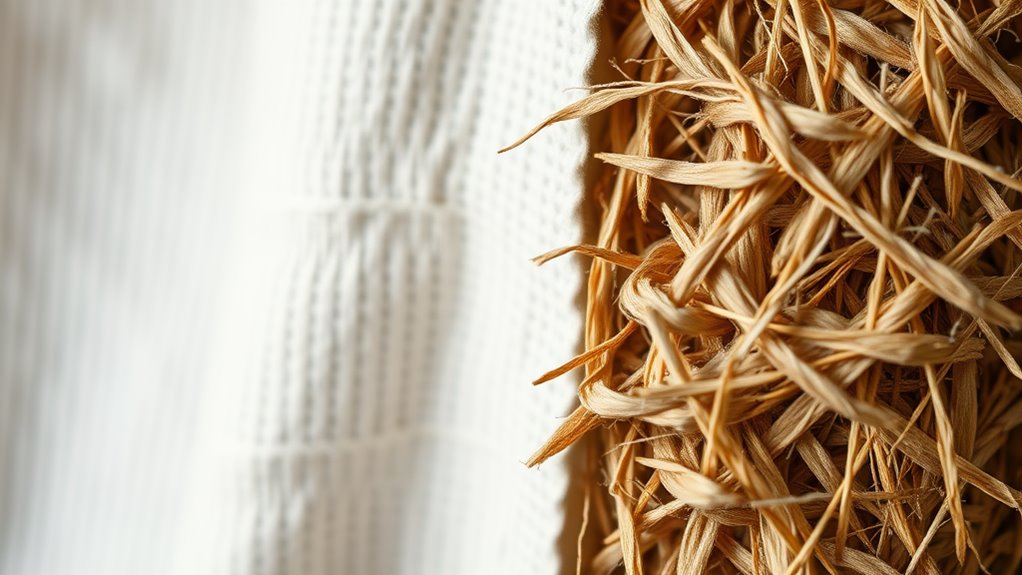
When comparing durability and strength, the differences in fiber composition between linen and hemp become apparent. Hemp's robust structure often leads to greater tear and wear resistance, making it a preferred choice for long-lasting products. Furthermore, the lifespan and longevity of hemp fabrics usually surpass those of linen, highlighting their unique advantages.
Fiber Composition Differences
Though both linen and hemp are renowned for their natural fibers, their durability and strength differ markedly due to their unique compositions. Linen, derived from the flax plant, boasts a smooth and fine fiber structure, making it strong yet susceptible to wear over time. Hemp, conversely, is sourced from the hemp plant, featuring thicker and more robust fibers that contribute to its exceptional durability. This resilience makes hemp an increasingly popular choice among those embracing sustainability practices. Both fibers are eco-friendly, but hemp's strength often leads to longer-lasting products, which aligns with a growing consumer preference for sustainable fiber sources. Comprehending these differences can help consumers make informed choices for their textiles.
Tear and Wear Resistance
Though both linen and hemp are valued for their durability, hemp's tear and wear resistance greatly outshines that of linen. Hemp fibers are inherently stronger and more robust, making them less prone to tearing under stress. This exceptional tear resistance means hemp fabrics can endure heavy use without showing signs of wear. Conversely, although linen is strong, it's more susceptible to fraying and damage over time, particularly when exposed to harsh conditions. The wear resistance of hemp guarantees that items made from it can withstand the rigors of daily life, making them ideal for everything from clothing to home textiles. When durability is a priority, hemp clearly stands out as the superior choice between the two.
Lifespan and Longevity
The longevity of fabric greatly depends on its inherent strength and resilience. Linen and hemp both offer impressive durability, but their lifespan factors can differ markedly. Linen, as it is strong, is more prone to wear over time compared to hemp, which boasts exceptional tensile strength. This durability leads to longevity benefits, making hemp a preferred choice for items exposed to rigorous use.
| Fabric | Lifespan Factors |
|---|---|
| Linen | Lower strength, more wear |
| Hemp | High strength, less wear |
| Linen | Softens but weakens over time |
| Hemp | Maintains integrity longer |
| Linen | Requires careful care |
| Hemp | Resilient with minimal care |
Choosing between them often comes down to the intended use and desired longevity.
Uses and Applications
Linen and hemp are versatile materials that find a wide range of uses across various industries. In fashion, linen's breathable quality makes it a popular choice for summer clothing, whereas hemp's durability lends itself to rugged apparel and accessories. Both fabrics are often favored for their natural aesthetics and comfort.
In terms of applications in the home, linen is commonly used for bed linens, curtains, and tablecloths, adding an elegant touch to interiors. Hemp, in contrast, serves well in making eco-friendly ropes, rugs, and even insulation materials. These materials not only improve functionality but additionally contribute to a stylish, sustainable lifestyle, appealing to consumers who prioritize both quality and environmental consciousness. Additionally, the benefits of sleeping on linen include enhanced breathability and moisture-wicking properties, which help regulate body temperature for a more comfortable rest. This makes linen an excellent choice for those who value both comfort and durability in their bedding. Meanwhile, hemp’s natural resistance to pests and mildew ensures long-lasting usability in various household applications.
Environmental Impact
Although both linen and hemp are celebrated for their eco-friendly attributes, they each have distinct environmental impacts throughout their lifecycle. Linen, derived from the flax plant, requires fewer pesticides and fertilizers, making it a sustainable choice. Nevertheless, its water usage can be high during cultivation. Conversely, hemp is known for its low ecological footprint; it grows quickly, needs minimal water, and can thrive without harmful chemicals. Hemp's deep roots additionally improve soil health, supporting sustainability practices in agriculture. Ultimately, although both fabrics offer eco-friendly options, hemp tends to have a more positive overall impact on the environment because of its efficient growth and reduced resource demands. Consumers seeking sustainable textiles may prefer hemp for its lower ecological footprint.
Care and Maintenance
When considering sustainable fabrics like linen and hemp, care and maintenance play a significant role in their longevity and performance. Both fabrics require specific cleaning techniques to preserve their natural fibers and texture. Linen benefits from gentle washing in cold water and should be air-dried to prevent shrinkage. It's best to avoid bleach, as it can weaken the fibers. Hemp, conversely, can handle a bit more wear; it can be machine-washed in warm water and tumble-dried on low. For both materials, using mild detergents is crucial for effective fabric care. Regularly checking for stains and addressing them swiftly will likewise help maintain their appearance, ensuring these sustainable choices can be enjoyed for years to come.
Cost Comparison
Cost can be a significant factor when choosing between linen and hemp fabrics. Both options vary in price because of several cost factors, making a price comparison crucial for informed decisions.
- Production Expenses: Linen typically requires more labor-intensive processes, raising its cost.
- Raw Material Availability: Hemp is often more sustainable and easier to grow, which can lower its price.
- Durability and Longevity: Although linen may be pricier, its durability can justify the investment over time.
Ultimately, consumers should weigh these factors against their budget and needs. Comprehending the cost differences between linen and hemp can help individuals choose the fabric that best fits their financial and lifestyle preferences.
Frequently Asked Questions
Can Linen and Hemp Be Blended for Textiles?
Blending linen and hemp for textiles is possible and often beneficial. Many designers use various blending techniques to combine the strengths of both fibers, creating fabrics that possess improved durability and breathability. These blended textiles find applications in clothing, home furnishings, and accessories, offering a unique combination of texture and appearance. By incorporating both materials, textile manufacturers can meet the diverse needs of consumers as they promote sustainable practices in fashion and design.
Are There Any Allergies Associated With Linen or Hemp?
In terms of allergies, one might think linen and hemp are the ultimate foes, causing epic allergic reactions and skin irritation! Nevertheless, that's hardly the case. Most people don't experience any issues with either fabric. Linen, derived from flax, is commonly hypoallergenic, whereas hemp's natural properties make it unlikely to provoke allergies. Still, a few individuals might react, so it's wise to test for sensitivity before plunging headfirst into these fabulous fabrics!
How Do Linen and Hemp Affect Skin Sensitivity?
When considering how linen and hemp affect skin sensitivity, it is crucial to recognize that both fabrics are usually hypoallergenic. Linen, being a natural fiber, tends to be less likely to cause skin irritation, whereas hemp is likewise known for its low sensitivity levels. Nevertheless, individuals' reactions can vary. Some might find hemp's texture slightly rougher, which could lead to mild irritation for those with particularly sensitive skin. In general, both fabrics are typically safe choices.
What Are the Historical Uses of Linen and Hemp?
In the fabric of history, ancient textiles like linen and hemp weave stories of cultural significance. Linen's smooth fibers adorned the bodies of pharaohs, symbolizing purity and wealth, whereas hemp's sturdy structure served as a backbone for sails and ropes, representing strength and resilience. Both materials, cherished throughout centuries, reflect humanity's ingenuity and adaptability, showcasing their essential roles in daily life, trade, and ceremonial practices across diverse civilizations. Their legacy continues to inspire today.
How Do Linen and Hemp Compare in Terms of Fire Resistance?
In relation to fire resistance, both linen and hemp have unique properties that affect their performance. Linen's natural fibers tend to ignite easily but burn quickly, while hemp is typically regarded as more fire-resistant because of its denser structure. Nevertheless, neither fabric fully meets strict safety standards for flame retardancy. In situations where fire safety is a concern, it's important for consumers to take these differences into account when selecting materials for specific applications.


